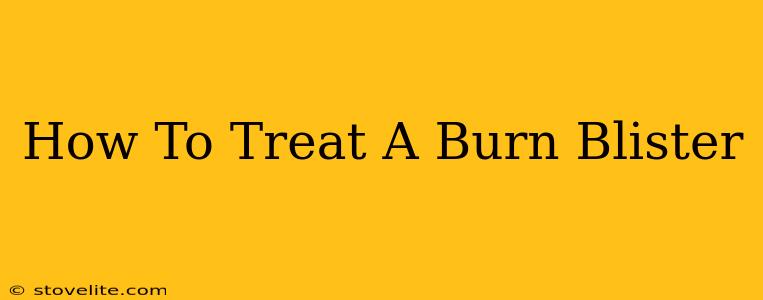Burn blisters are a common occurrence, whether from a brief encounter with a hot stove or a longer exposure to the sun. Knowing how to treat a burn blister properly is crucial for preventing infection and promoting faster healing. This comprehensive guide will walk you through the steps to effectively care for your burn blister, minimizing discomfort and scarring.
Understanding Burn Blisters
Before we dive into treatment, it's important to understand what a burn blister actually is. A blister forms when the skin's deeper layers are damaged by heat, causing fluid to accumulate beneath the outer layer of skin. This fluid acts as a protective barrier, helping the underlying tissue heal. Do not pop the blister! Breaking the blister increases the risk of infection and slows down the healing process.
Types of Burns and Blister Severity
The severity of a burn, and therefore the necessary treatment, depends on its depth:
- First-degree burns: These are superficial burns affecting only the outer layer of skin (epidermis). They typically cause redness, pain, and mild swelling. Blisters are less common with first-degree burns.
- Second-degree burns: These burns involve the epidermis and part of the dermis (the layer beneath the epidermis). They're characterized by redness, swelling, pain, and the formation of blisters. Second-degree burns require more careful attention.
- Third-degree burns: These are severe burns that extend through all layers of the skin and may even damage underlying tissues. They often appear white or charred, and there may be little to no pain initially due to nerve damage. Third-degree burns require immediate medical attention.
Treating a Burn Blister at Home
For first and some second-degree burns with blisters, home treatment is usually sufficient. Always seek medical advice if you are unsure about the severity of the burn or if it covers a large area of your body.
1. Cool the Burn Immediately
The first step is to immediately cool the burn under cool (not cold!) running water for 10-20 minutes. This helps to reduce pain and inflammation. Avoid ice, as it can further damage the skin.
2. Clean the Burn Gently
Once cooled, gently clean the area with mild soap and water. Pat the area dry with a clean towel. Avoid scrubbing, as this can irritate the blister and increase the risk of infection.
3. Protect the Blister
Keep the blister covered with a clean, loose-fitting bandage. This protects it from further injury and infection. A non-stick dressing is ideal. Change the bandage daily or as needed, ensuring the area remains clean and dry.
4. Pain Relief
Over-the-counter pain relievers like ibuprofen or acetaminophen can help manage pain and inflammation. Follow the recommended dosage on the packaging.
5. Avoid Popping the Blister
Resist the urge to pop the blister! The fluid inside helps protect the wound and promotes healing. Popping it increases the risk of infection and scarring.
6. Keep it Clean and Dry
Maintaining cleanliness is paramount. Keep the area clean and dry to prevent infection. Avoid harsh soaps, lotions, or creams unless recommended by a healthcare professional.
7. Monitor for Infection
Watch for signs of infection, such as increased pain, redness, swelling, pus, or fever. If you notice any of these symptoms, seek medical attention immediately.
When to See a Doctor
While many burn blisters can be treated at home, it’s essential to seek medical attention if:
- The burn is severe (third-degree).
- The blister is large or covers a significant area of your body.
- The burn is on your face, hands, feet, genitals, or joints.
- You have signs of infection (increased pain, redness, swelling, pus, fever).
- You have diabetes or another condition that impairs healing.
By following these steps and seeking medical attention when necessary, you can effectively treat a burn blister and promote rapid, healthy healing. Remember, prevention is always better than cure, so be mindful of potential burn hazards in your environment.

